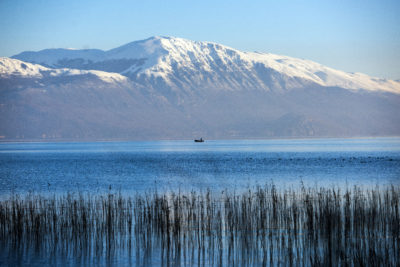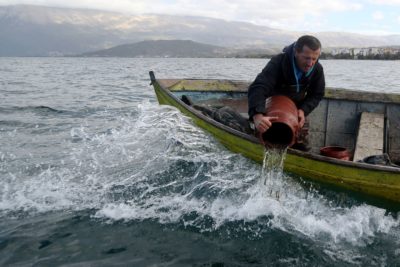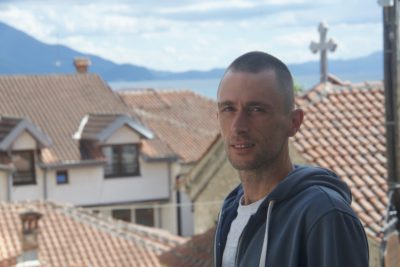On a spring morning, the oldest freshwater lake in Europe lies flat and calm, its wide surface shining. Distant mountains rise in gauzy shades of rose and purple, while water as clear as glass laps against the stony beach. Not far away, a town whose history dates to Greek and Roman antiquity spreads itself along the shore, its white-walled houses gleaming.
Lake Ohrid is almost 2 million years old. Cupped in mountains at the border between North Macedonia and Albania, it is one of fewer than three dozen ancient lakes around the world. These lakes are scattered geological rarities, deep reservoirs of biodiversity, and centers of evolution.
As ancient lakes go, Ohrid is not big — just 19 miles long, nine miles wide and 945 feet deep. But scientists say that, acre for acre, it may be the most diverse lake in the world, teeming with fish, snails, leeches, flatworms, phytoplankton, crustaceans, and more. Of the lake’s roughly 1,200 known native species, 212 of them are endemic, occurring nowhere else.
But Ohrid is also in trouble. It faces growing threats, including from overfishing, nutrient pollution, invasive species, booming tourism, unregulated building, official neglect, and perhaps the most inexorable challenge of all, global warming.
Because ancient lakes contain so many species found nowhere else, once they are degraded, they cannot be fully restored.
Scientists and local activists are worried. Christian Albrecht, a German ecologist at the University of Geissen who has studied the lake, warns of a “creeping biodiversity crisis.” He and other scientists are concerned that if the lake’s problems continue unchecked — problems highlighted in a recent report submitted to the Council of Europe by Andrej Sovinc, a protected areas expert with the International Union for Conservation of Nature — endemic species will decline or disappear. The character of Ohrid as a treasure of biodiversity and a showpiece of evolution, scientists say, could be irreversibly harmed.
“There is of course some resilience,” Albrecht said. “There is fresh water coming all the time from the mountains… The problem is if you have this multitude of pressures, or stressors. At some point every ecosystem will find a tipping point… We really need to be alarmed.”
Ohrid is far from alone. From Tanganyika in East Africa to Baikal in Siberia and Titicaca in South America, the world’s ancient lakes face threats similar to those facing Lake Ohrid. In some places scientists are already seeing a decline in endemic species, including diatoms at the bottom of the food chain in Baikal and the small cichlid fish species that abound in Lake Tanganyika and nearby Lake Malawi.
Most of the planet’s lakes are young — less than 10,000 years old — and were formed by glaciation. Ancient lakes, by contrast, were formed by the shifting of mountains, often over millions of years. A smaller number fill the craters of asteroids that hit the earth long ago. A 2018 survey listed 29 ancient lakes around the world, ranging in age from roughly 130,000 years to more than 65 million years.
Ancient lakes have long fascinated scientists for their remarkable biodiversity and the large number of endemic species that evolved — and survived — in these bodies of water over their long existence. Early studies focused on cataloging lake diversity. More recently, scientists have been studying the lakes’ environmental history, hoping to better understand how evolution produced so many species. Using techniques as disparate as DNA analysis and the deep coring of sediments, they have examined the ways in which past changes in climate and local conditions affected both the timing and direction of speciation. One thing is clear: ancient lakes have served both as cradles of new species and as refuges for established species over periods of change.
There’s much that scientists don’t know about ancient lakes. They’re big and deep, and therefore relatively resistant to significant change. But scientists say they’re also vulnerable, in part because the problems they face have been building over decades, including climate change, nutrient pollution, and overfishing. Also, because ancient lakes contain so many species found nowhere else, once they are degraded, they cannot be fully restored.
One study found that visibility in Lake Ohrid had shrunk from a depth of 54 feet in 1920 to 43 feet by 2005.
“If some pieces get lost, it’s something we’ll never get back,” said Catherine O’Reilly, an ecologist at Illinois State University who has studied climate change and its effect on fish populations in Lake Tanganyika. In addition to curbing nutrient pollution and reducing overfishing, scientists have suggested giving greater protection to parts of lakes that are either representative of the whole or exceptionally high in biodiversity.
North Macedonia is one of the poorest countries in Europe, with high unemployment, low wages, and few resources. Tourism has been one of the few ways to boost the economy in recent years. Visitors come for Ohrid’s beauty, but also because it’s relatively affordable.
To accommodate and attract these visitors, new hotels, apartments, and restaurants have been built, and are still being built, near the lake, despite a ban on new construction within 50 meters of the shore. The new buildings, together with new marinas and an increase in boat traffic, have destroyed or harmed habitat, including marshlands and reed beds, in many areas.
Pollution has also increased from poorly functioning municipal treatment systems — and sometimes from sewage lines emptying directly into the water — and from agricultural pollution in the watershed. Nutrients from both sources are causing algae to accumulate on rocky lake bottoms near populated areas, turning clear water cloudy and degrading shallow-water habitat for native species. Studies in nearshore areas have also found a shift from diatoms and invertebrates that thrive in a low-nutrient environment toward species that thrive in a nutrient-rich environment.
A fisher releases young Ohrid trout back into the Albanian portion of Lake Ohrid last November.
Adnan Beci / AFP via Getty Images
Lake Ohrid and other cold-water ancient lakes are oligotrophic, or low in nutrients, which explains their remarkable clarity. Oligotrophic lakes are also rich in oxygen — and life — all the way to the bottom. But over decades, the clarity of Ohrid’s water has declined. One study found that visibility had shrunk from a depth of 54 feet in 1920 to 43 feet by 2005. Scientists have noticed changes in species composition in the deepest water, including deep water algal blooms and an increase in minnows that feed on that algae. The range of some mussels has shrunk. Some snails have become rare.
The most famous species in Ohrid is the Ohrid trout. It’s endemic to the lake and has long graced local dinner tables. But overfishing has so reduced its numbers that catching it is now illegal on the Macedonian side, though people say poaching is common. At the same time, the Ohrid trout faces new competition from seven introduced species of fish, including rainbow trout. Other invasive species have found their way into the lake, including two new snail species, though these have yet to displace any of the natives. More worrisome may be the proximity of zebra and quagga mussels, native to the Black Sea, which have wrought so much ecological damage in the Great Lakes, in North America. They could easily reach Lake Ohrid attached to a boat, in the water of a bait bucket, or on some bit of gear.
“To me it’s just a matter of time,” Albrecht said. “And what happens when they meet the native mussels?”
Some people are afraid to criticize government inaction for fear of getting in trouble with local authorities, says a conservationist.
Gastropods, a classification that contains snails and slugs, are one of the most diverse groups in the lake. Scientists have discovered 68 species of snails, three quarters of them endemic. But for these tiny organisms, even small changes — such as algae colonizing rocks — can have big effects, Albrecht said. “Where you had a meadow of aquatic grasses, all of a sudden you find yourself in an algae forest. These changes are drastic and can definitely lead to the disappearance and local decline of these animals.”
Climate change poses a bigger challenge. Scientists fear that rising surface temperatures will lead to greater stratification of the water column and less mixing. This could deprive the deeper water of oxygen, imperiling the many endemic species that live there. Nutrient pollution, especially phosphorous from sewage, heightens this effect by further reducing oxygen levels. Researchers have estimated that if temperatures rise as predicted by the end of the century, the phosphorus in Ohrid would need to be cut in half to keep its depths from becoming so low in oxygen that deep water creatures will not survive.
Ohrid is not without its defenders. The local conservation movement is small but passionate, its members few but deeply attached to the lake. Nikola Paskali is one of them. A diver, archeological enthusiast, and conservationist, he has spent years exploring the lake. He recently made a series of videos for schoolchildren, sponsored by the United Nations, to call attention to its problems.
But arousing concern for the lake is hard in a country as poor as North Macedonia, he said. “When we fix social problems, afterward it’s possible to fix the ecological problems with the lake.”
Among the most determined activists are members of Ohrid SOS, a small group that has labored to bring the lake’s problems — including illegal construction and the degradation of the lake’s last intact wetland — to the attention of a wider public. But political action is risky, said Katerina Vasileska, a local tour guide and SOS member. She said some people are becoming more interested in the environment and in her group’s work, but they are afraid to speak out or to criticize government inaction for fear of getting in trouble with local authorities or losing their jobs. (The Ohrid Municipality declined to make anyone available to comment.)
“People are aware a lot more,” Vasileska said. “But they are not willing to fight. They are kind of passive.”
Dusica Ilek-Boeva, a biologist at the PSI Hydrobiological Institute Ohrid, a research center founded at the lake in 1935, is more hopeful. She’s also a teacher, and on a recent spring day she introduced a group of ninth graders from the capital, Skopje, three hours away, to the Lake Ohrid ecosystem. While she explained food chains using a computer diagram, the students poked at samples of sediment from a nearby spring and other areas connected to the lake, plucking out with tweezers the tiny squirming creatures that contribute to Ohrid’s enormous biodiversity.
Ilek-Boeva was pleased. She thinks the next generation will do better. “If this lake has been here for 2 million years,” she said to the students, “I hope it will survive us.”
- SEO Powered Content & PR Distribution. Get Amplified Today.
- PlatoData.Network Vertical Generative Ai. Empower Yourself. Access Here.
- PlatoAiStream. Web3 Intelligence. Knowledge Amplified. Access Here.
- PlatoESG. Carbon, CleanTech, Energy, Environment, Solar, Waste Management. Access Here.
- PlatoHealth. Biotech and Clinical Trials Intelligence. Access Here.
- Source: https://e360.yale.edu/features/lake-ohrid-ancient-lakes-climate-change



